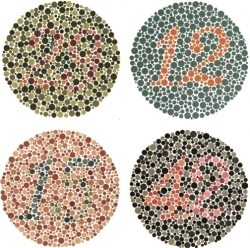Molecular Medicine
Molecular Medicine is More Than Gene Diagnostics or Genetics
The recently completed sequence information of the human genome is an important tool to understand the molecular basis of a disease. However, genetic analysis provides us only with a static picture - a photo. Every process of life is regulated by a controlled up- and downregulation of a series of genes and is a dynamic process - a film. Not only defective genes but also an excessive or incomplete up- or downregulation of a gene can cause a disease.
diagene devotes itself to molecular research and to the transfer of the discoveries of molecular research to medicine, to molecular medicine.
Examples for Functional Sequence Variations
Examples for sequence variations whithin genes that cause functional changes.
Color Blindness
Color blindness is a frequent variant defined by the reduced ability to distinguish between certain colors or wavelengths of light. The most common forms of color blindness are inherited and are associated with the inability to discriminate red and green wavelengths (red-green color blindness). This disorder arises from alterations in specific sequence variations in genes located on the X-chromosome, which encode the middle-wave (green) and long-wave (red) sensitive photopigment molecules. The frequency (or better prevalence) of individuals having color blindness are much higher in males (8.0%), because males possess only one X-chromosome. In females, the prevalence is much lower (0.5%) because the second X-chromosome can contribute the information to generate a middle-wave (green) and long-wave (red) sensitive photopigment protein.
If you have a properly functioning color monitor and you cannot read the numbers within the four circles below, it might be possible that you belong to those individuals that have a certain form of color blindness.

Tables to detect color blindness: you should be able to recognize the following numbers (from left to right) in these four circles: "29", "12", "15", "42".
